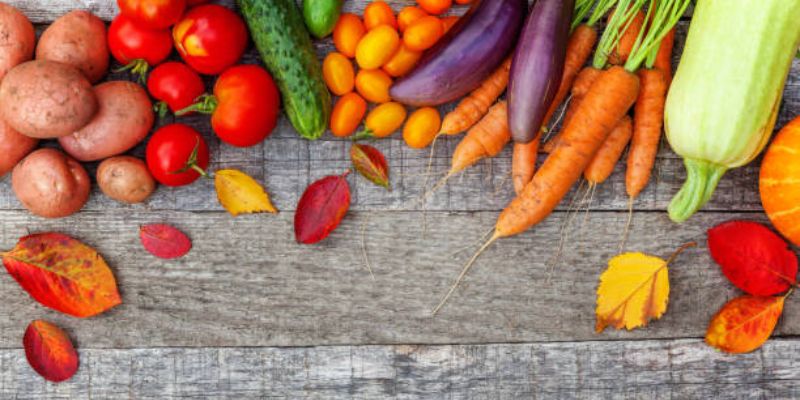Growing vegetables above ground is vital to worldwide farming and healthy eating. These vegetables vary in type and flavor, offering different nutritional benefits.
The humble tomato, spinach, and kale are versatile in cooking and key for health. Growing these plants benefits farmers economically and lets gardeners enjoy fresh produce.
20 Vegetables That Grow Above Ground
Vegetables growing above ground come in many types, all rich in vitamins and minerals, making them essential for a healthy diet. Unlike root vegetables, these plants grow with their edible parts exposed to air and sunlight.
This exposure changes their nutritional content and flavor. Here is a brief overview of vegetables that grow above the ground:
Tomatoes
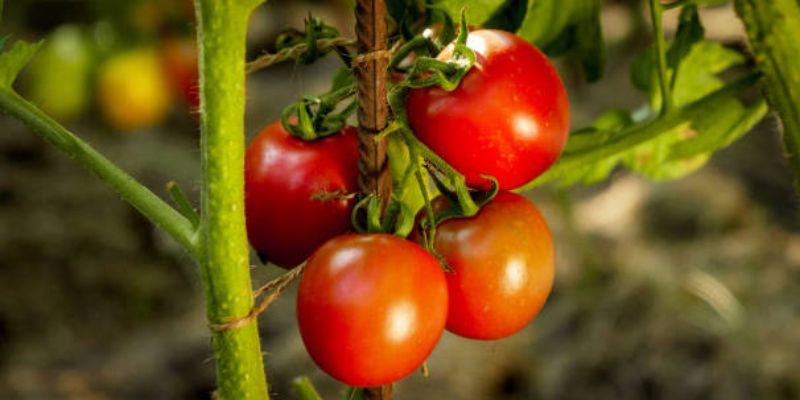
Though often called vegetables, Tomatoes are fruits because they have seeds. They are a staple in gardens and kitchens worldwide due to their versatility and health benefits.
Characteristics
- Varieties: A wide range of tomato varieties exists, from small cherry tomatoes to large beefsteaks, in classic red, yellow, green, and even purple.
- Flavor: Depending on the variety, tomato flavors range from sweet to tart and tangy.
- Shape: Tomato shapes vary, including spherical, elliptical, and even ribbed, with each variety having its unique profile.
Nutritional Value
- Vitamins: Tomatoes are excellent sources of vitamin C, potassium, folate, and vitamin K.
- Antioxidants: Tomatoes contain high levels of antioxidants like lycopene, linked to many health benefits.
Growing Conditions
- Climate: Tomatoes require a warm environment and at least six hours of sunlight daily.
- Soil: They thrive in well-draining soil rich in organic matter.
- Watering: Water the plants regularly, especially when the fruits start forming.
Cultivation Methods
- Planting: People often start growing tomatoes inside and move them outdoors after the last frost.
- Support: Many varieties need staking or caging to support their growth.
- Pruning: Cutting off unwanted shoots helps focus the plant’s energy on making fruits.
Uses In Cuisine
- Raw: Often eaten raw in salads, sandwiches, and garnishes.
- Cooked: Used as a base for sauces, soups, and stews.
- Preserved: Can be canned, dried, or made into pastes and purees for long-term storage.
Tomatoes add flavor to dishes and are rich in antioxidants and vitamins that improve heart health and offer other benefits. Their adaptability in cooking and ease of growth make them a favorite among gardeners and chefs.
Bell Peppers
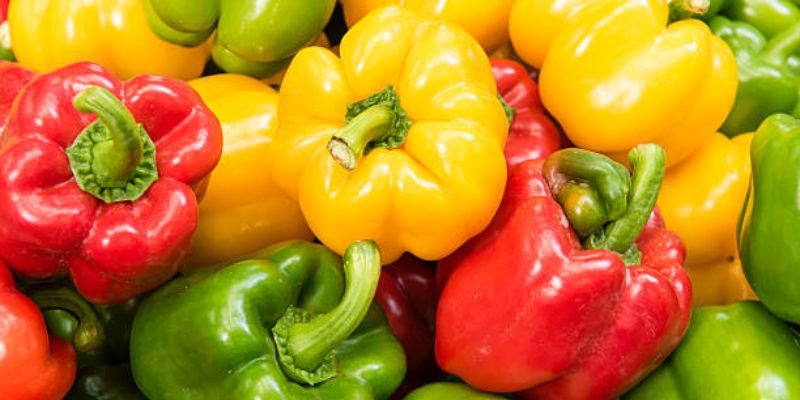
Bell peppers, also called sweet peppers, are colorful and versatile vegetables growing above ground. Bell peppers are known for their crisp texture and sweet flavor, which varies slightly with color. They are an integral part of cuisines worldwide, valued for their taste and nutritional benefits.
Characteristics
- Varieties: Bell peppers come in various colors, including green, red, yellow, orange, and sometimes purple or brown.
- Flavor: Green bell peppers are slightly bitter, while red, orange, and yellow varieties are sweeter and fruity.
- Texture: Bell peppers have a crunchy texture when raw, which softens when cooked.
Nutritional Value
- Vitamins: Red bell peppers especially contain more vitamin C than green ones, making them an excellent nutrient source. They are also a good source of vitamin B6, vitamin K1, vitamin E, and potassium.
- Antioxidants: Bell peppers contain antioxidants such as capsanthin in red varieties, known for anti-inflammatory properties.
Growing Conditions
- Climate: Bell peppers thrive in warm, sunny environments and require a long growing season.
- Soil: They prefer well-draining, fertile soil with a pH between 6.0 and 6.8.
- Watering: Regular, consistent watering is essential, especially during the flowering and fruiting stages.
Cultivation Methods
- Starting Seeds: Gardeners often begin the seeds indoors and transplant them outside after the last frost threat has passed.
- Spacing: Space the plants properly to ensure they get enough air and sunlight.
- Support: Some gardeners use stakes or cages to support the growing plants.
Uses In Cuisine
- Raw: Commonly eaten raw in salads, as crudité, or as a crunchy snack.
- Cooked: Used in various cooked dishes, from stir-fries to fajitas, and are excellent when grilled or roasted.
- Stuffed: Large bell peppers are perfect for stuffing with rice and meat or vegetarian fillings.
Bell peppers add color to meals and are healthful and rich in vitamin C and antioxidants. They are relatively easy to grow, making them popular among home and commercial growers. Their wide range of uses in the kitchen adds to their appeal.
Broccoli
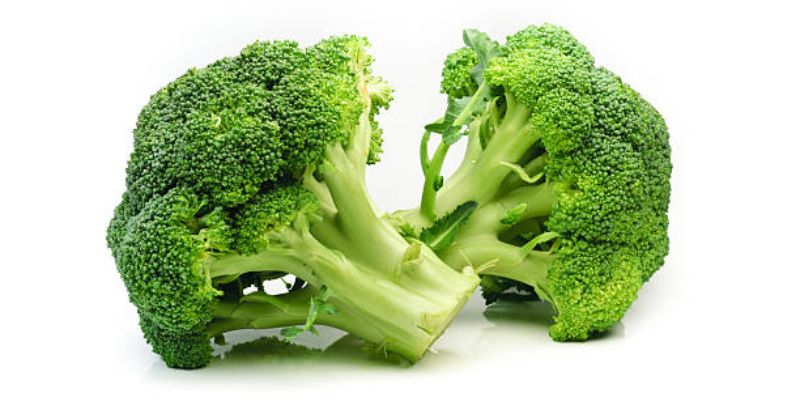
Broccoli, a widely consumed vegetable, grows above ground and is known for its green florets and stalk. It belongs to the cruciferous family, including vegetables like cauliflower and Brussels sprouts. Broccoli is celebrated for its nutritional benefits and versatility in various culinary traditions.
Characteristics
- Appearance: Broccoli features large green heads, or crowns, with tight florets and often includes long, sturdy stalks with leaves.
- Taste: It has a slightly bitter and earthy flavor, which can be reduced through cooking.
- Varieties: Several broccoli varieties exist, such as Calabrese, sprouting broccoli, and broccoli raab (rapini), varying slightly in taste and appearance.
Nutritional Value
- Rich in Vitamins and Minerals: Broccoli is high in vitamins C and K and contains good folate, potassium, and fiber.
- Antioxidants: Rich in antioxidants such as sulforaphane, broccoli may reduce inflammation and improve heart health.
Growing Conditions Climate
Broccoli thrives in cooler weather and can tolerate light frosts.
- Soil: Broccoli grows best in well-drained, fertile soil with a slightly acidic to neutral pH.
- Watering: Consistent watering is essential, especially as the heads form.
Cultivation Methods Planting
Broccoli can be grown from seeds or transplants. Planting at the right time is crucial to avoid hot weather during harvest.
- Spacing: Adequate space is needed between plants to ensure proper growth.
- Pest Control: Since broccoli is prone to pests, it might need natural or chemical control methods.
Uses In Cuisine Versatile In Cooking
You can consume broccoli in various ways: raw in salads, cooked by steaming, boiling, roasting, stir-frying, or added to soups and casseroles.
- Nutrient Retention: Cooking methods like steaming help retain its nutritional value.
- Complementary Flavors: It pairs well with garlic, cheese, lemon, and almonds.
Broccoli’s high nutritional value, particularly its vitamin C and K content and potential health benefits, make it a popular diet choice.
Broccoli’s versatility in cooking and easy cultivation make it popular in home gardens and commercial farming.
Cauliflower
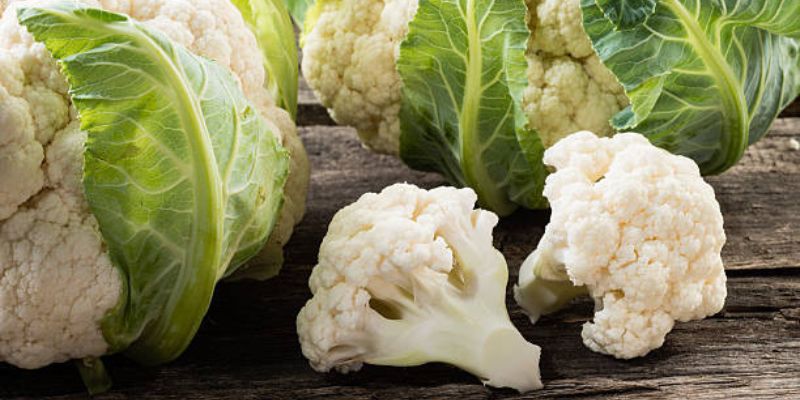
Cauliflower is a versatile and popular vegetable grown above ground, known for its distinctive white heads and nutritional benefits. Cauliflower, a cruciferous vegetable like broccoli, kale, and Brussels sprouts, is valued for its cooking versatility and health benefits.
Characteristics Appearance
Cauliflower has a white, compact head, also known as a ‘curd,’ with green leaves around it. Some varieties come in colors like purple, orange, and green.
- Taste: It has a mild, slightly nutty flavor that becomes sweeter and more pronounced when roasted.
- Varieties: Several varieties exist, such as the standard white cauliflower, Romanesco with a fractal pattern, and colorful ones like purple and orange.
Nutritional Value Rich In Nutrients
Cauliflower is high in vitamins C and K and contains good folate, pantothenic acid, and vitamin B6.
- Low in Calories: It’s low in calories but high in fiber, making it an excellent option for weight-conscious diets.
- Antioxidants: Cauliflower contains sulforaphane and isothiocyanates, which are linked to a lower cancer risk.
Growing Conditions
- Climate: Cauliflower likes cool temperatures but is more complicated to grow than related plants because it reacts strongly to temperature changes.
- Soil: It thrives in well-drained, fertile soil with consistent moisture.
- Watering: Regular and enough water is critical for the cauliflower head to grow well.
Cultivation Methods
- Planting: You can grow cauliflower from seeds or transplants. Sometimes, you need to cover the head of white types to keep their color.
- Spacing: Requires adequate space for growth, typically around 18-24 inches between plants.
- Pest Control: Cauliflower is prone to pests, similar to broccoli, and might need protection.
Uses In Cuisine
- Versatile in Cooking: Cauliflower can be cooked in many ways: roasted, steamed, boiled, fried, or raw. It’s famous as a low-carb substitute for cauliflower rice, pizza crusts, and mashed ‘potatoes.’
- Flavor Pairings: Pairs well with various herbs and spices, including garlic, curry, and cheese.
- Nutrient Retention: The best cooking methods for retaining nutrients include steaming and stir-frying.
Cauliflower’s popularity has surged due to its nutritional profile and role in various dietary trends, such as vegetarian, vegan, and low-carb diets. Its ability to absorb flavors and mimic other textures makes it a favorite in creative and health-conscious cooking.
Lettuce

Lettuce is a widely consumed leafy green vegetable that grows above ground and is known for its role as a staple in salads.
Lettuce belongs to the Asteraceae family and is valued for its easy growth, nutritional benefits, and culinary versatility.
Characteristics
- Varieties: There are several types of lettuce, including iceberg, romaine, butterhead (Boston and Bibb), and loose-leaf varieties. Each has a distinct texture and flavor.
- Texture and Flavor: Iceberg lettuce has a crisp texture and mild flavor, while romaine combines a crunchy spine with tender leaves and a slightly bitter taste. Butterhead varieties have a tender texture and sweet flavor. In contrast, loose-leaf lettuces provide a delicate and often somewhat sweet flavor.
- Appearance: The appearance varies widely across types, from tightly packed heads to loose, open leaves.
Nutritional Value
- Low in Calories: Lettuce is extremely low in calories, making it a popular choice for weight-loss diets.
- Vitamins and Minerals: Lettuce is a good source of vitamins A and K, with some types also providing moderate amounts of vitamin C and folate.
- Hydration: High water content makes it refreshing and hydrating.
Growing Conditions Climate
Most lettuce varieties prefer cooler weather and can be grown in spring and fall in most climates. Extreme heat can make lettuce bolt or go to seed and become bitter.
- Soil: Lettuce prefers well-drained, fertile soil rich in organic matter.
- Watering: Lettuce requires consistent moisture but cannot thrive in waterlogged soil.
Cultivation Methods Planting
Lettuce can be grown from seeds or transplants, and practicing succession planting allows for a continuous harvest.
- Spacing: Space requirements vary by type, but generally, lettuce plants need about 6-12 inches of space.
- Harvesting: Gardeners can harvest the outer leaves for some lettuce varieties while allowing the plant to keep growing.
Uses In Cuisine Salads
A foundational ingredient for a wide variety of salads.
- Wraps and Sandwiches: Used as a wrap for fillings or a crunchy sandwich addition.
- Cooked Dishes: Some types, like romaine, can be grilled or added to soups.
Lettuce’s various varieties provide a range of textures and flavors, enhancing its versatility in culinary uses. Easy to grow and harvest, lettuce is standard in home gardens and commercial agriculture.
Cucumbers
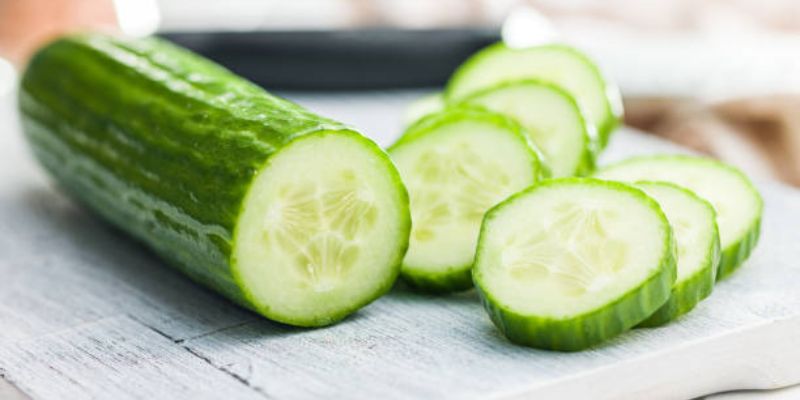
Cucumbers are a widely grown vegetable known for their crisp texture and refreshing taste. Cucumbers are technically fruits but are commonly treated as vegetables in cooking.
They belong to the Cucurbitaceae family, which includes melons and squash. They are favored for their ease of growth and versatility in cooking and fresh consumption.
Characteristics
- Varieties: Cucumbers come in several varieties, such as slicing for fresh eating and smaller pickling cucumbers for making pickles. Some cucumber varieties thrive in greenhouse conditions.
- Texture and Flavor: Cucumbers taste mild and slightly sweet, offering a refreshing sensation.
- Appearance: Cucumbers are usually elongated and green, with colors ranging from light to dark green. However, some varieties can be yellow or white.
Nutritional Value Hydration
Cucumbers are very high in water content, making them incredibly hydrating.
- Low In Calories: Cucumbers are low in calories but can provide a small amount of vitamins K and C, potassium, and magnesium.
- Fibre: Cucumber skin is a good source of dietary fiber.
Growing Conditions Climate
Cucumbers thrive in warm, sunny conditions.
- Soil: They prefer well-drained, fertile soil with a neutral pH.
- Watering: Cucumbers need consistent moisture, but avoiding overwatering them is essential.
Cultivation Methods Planting
Cucumbers are typically grown from seeds and can be direct-seeded or started indoors and transplanted.
- Spacing: Adequate space is necessary, and some varieties may require trellising to support their climbing habit.
- Pest and Disease Management: Cucumbers are prone to pests and diseases, such as cucumber beetles and powdery mildew, and thus require preventive measures.
Uses In Cuisine Raw Consumption
It is commonly eaten raw in salads, sandwiches, and as a garnish.
- Pickling: Smaller varieties are perfect for pickling.
- Cooked Dishes: Although less common, cucumbers can be used in cooked dishes, especially in some Asian cuisines.
Cucumbers are a staple in gardens and kitchens due to their refreshing taste and ease of cultivation. They are trendy summer dishes for their cooling effect and are a staple in diets focusing on hydration and low-calorie intake.
Zucchini
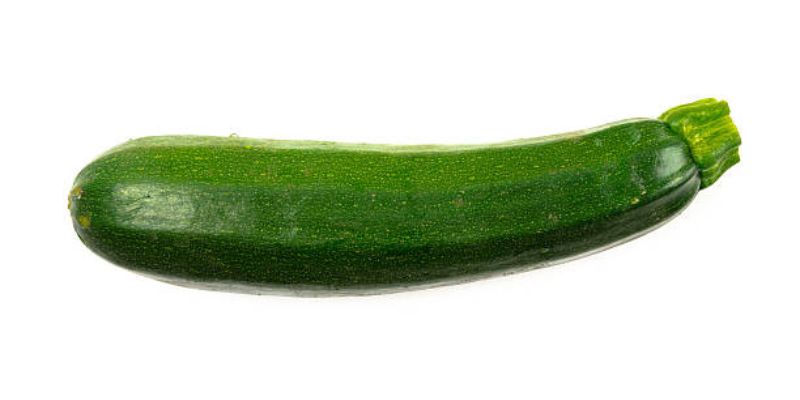
Zucchini, or courgette, is a popular summer squash valued for its versatility and mild flavor. Growing above ground, zucchini is part of the Cucurbita pepo species, which includes several squash varieties. Zucchini is a staple in gardens and kitchens, appreciated for its ease of growth and culinary flexibility.
Characteristics
- Varieties: Zucchini comes in various shapes and sizes, but the most common type is long and cylindrical with dark green skin. There are also yellow and striped varieties.
- Flavor and Texture: It has a mild, slightly sweet taste, with tender flesh that becomes more delicate when cooked.
- Growth Habit: Zucchini plants are typically bushy and can produce a high fruit yield throughout the growing season.
Nutritional Value
- Low in Calories: Zucchini is low in calories, making it a popular choice for weight-conscious diets.
- Vitamins and Minerals: It contains vitamin C, potassium, and other vitamins and minerals.
- Fibre: Zucchini provides dietary fiber, especially when eaten with its skin.
Growing Conditions
- Climate: Zucchini prefers warm, frost-free weather and well-drained soil.
- Soil: It thrives in nutrient-rich, well-drained soil.
- Watering: It needs consistent moisture without overwatering.
Cultivation Methods
- Planting: You can plant zucchini seeds directly in the garden once there’s no risk of frost. It can also be started indoors and transplanted.
- Spacing: Plants need ample space, usually about 2-3 feet apart, as they tend to spread out.
- Harvesting: Picking zucchini often makes the plant yield more fruit. Zucchini is best harvested from small to medium-sized for the best texture and flavor.
Uses In Cuisine
- Versatility: You can eat zucchini raw or cook it by steaming, grilling, sautéing, or baking into bread and desserts.
- Spiralized Zucchini: Zucchini is often a low-carb substitute for pasta when cut into spirals.
- Stuffed Zucchini: You can stuff large zucchini with different fillings.
Gardeners and cooks love zucchini for its easy growth and versatility in the kitchen. Its mild flavor makes it a suitable ingredient in various dishes, from savory to sweet. The vegetable’s low-calorie content and nutritional value make it a healthy addition to any diet.
Eggplant
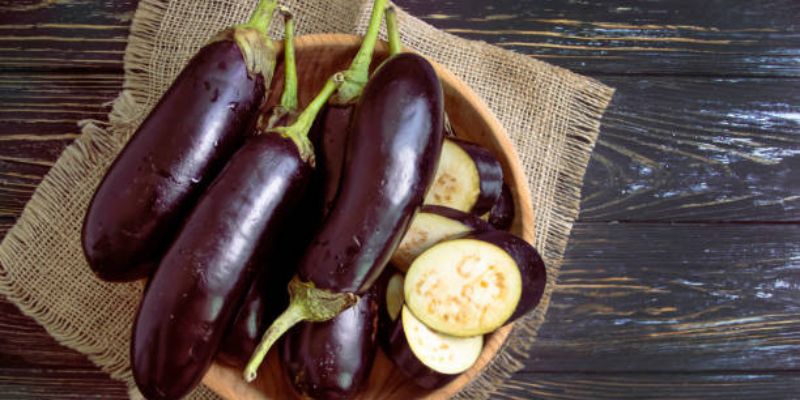
Eggplant, also known as aubergine, is a distinctive vegetable that grows above ground and is renowned for its unique texture and ability to absorb flavors.
Eggplant belongs to the nightshade family, along with tomatoes, bell peppers, and potatoes, and is a versatile ingredient in various global cuisines.
Characteristics
- Varieties: There are many varieties of eggplant, ranging from the large, bulbous, and deep purple types to smaller, slender, and lighter-colored ones.
- Flavor and Texture: Eggplants have a mildly bitter taste and a spongy texture that becomes tender when cooked. Salting and rinsing can reduce bitterness.
- Appearance: Eggplants are typically characterized by glossy skin and can range in color from deep purple to white, green, and even orange.
Nutritional Value
- Fibre Content: Eggplants are a good source of dietary fiber, which is beneficial for gut health.
- Low Calories: They are low in calories, making them a great addition to a weight-management diet.
- Antioxidants: Eggplants are rich in antioxidants, such as nasunin, found in the skin, which have been linked to various health benefits.
Growing Conditions
- Climate: Eggplants thrive in warm, sunny conditions and require a long growing season.
- Soil: They prefer fertile, well-drained soil with a slightly acidic to neutral pH.
- Watering: Regular, consistent watering is essential for fruit development.
Cultivation Methods
- Planting: Gardeners typically start the seeds indoors and move the plants outside after the last frost.
- Spacing: Plants need adequate growing space, usually 18-24 inches apart.
- Support: Gardeners might need to support some varieties with stakes because the fruit is heavy.
Uses In Cuisine
- Cooking Methods: You can cook eggplants in many ways, including grilling, roasting, baking, frying, or stewing.
- Dishes: Common in dishes like ratatouille, baba ghanoush, eggplant Parmesan, and moussaka.
- Pairings: Eggplants pair well with garlic, tomatoes, onions, and various herbs and spices.
Eggplants are a favorite in many gardens due to their unique texture and flavor-absorbing properties. Their versatility in the kitchen makes them a valuable ingredient in a wide array of dishes spanning different cuisines. The vegetable’s low-calorie yet nutrient-rich profile also contributes to its popularity in health-conscious cooking.
Green Beans
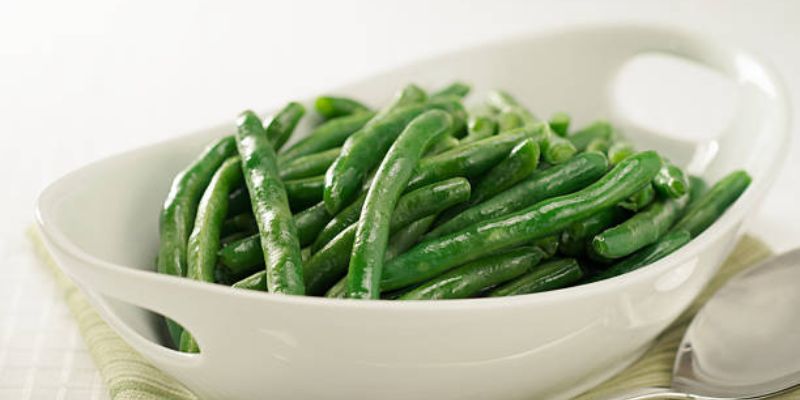
Green beans, also known as string beans or snap beans, are a popular vegetable that grows above ground. They belong to the legume family, famed for their crisp texture and mild flavor.
People around the world enjoy green beans. They are a staple in many cuisines because they are versatile and nutritious.
Characteristics
- Varieties: There are numerous varieties of green beans, including bush beans and pole beans. Bush beans, being compact, need little support. In contrast, pole beans, which grow on vines, require trellising.
- Flavor and Texture: Green beans have a crisp texture and a slightly sweet, grassy taste. Green bean pods are edible while young and tender.
- Appearance: Green beans are long and slender, typically green, although some varieties may be yellow or purple.
Nutritional Value
- Vitamins and Minerals: Green beans are rich in vitamins A, C, and K, folate, and fiber, and they also contain iron and calcium.
- Low in Calories: Green beans are low in calories but high in essential nutrients, making them a healthy addition to any diet.
- Antioxidants: Green beans contain antioxidants such as flavonoids and carotenoids, offering various health benefits.
Growing Conditions Climate
These plants grow best in warm weather but not in extreme heat. They prefer a sunny location.
- Soil: These plants thrive in well-drained soil rich in organic matter.
- Watering: They require consistent moisture, especially during flowering and pod development.
Cultivation Methods Planting
It can be directly sown in the garden after the last frost. Bush beans don’t require support, but pole beans need trellising.
- Spacing: Bush beans can be planted closely, while pole beans need more space for their vines.
- Harvesting: Harvest the beans while firm and full-sized before the seeds mature.
Uses In Cuisine Cooking Methods
Green beans can be steamed, boiled, stir-fried, or roasted. They should be cooked just until tender to preserve their crisp texture.
- Dishes: Used in various dishes, from salads and side dishes to casseroles and stews.
- Pairings: Complement flavors like garlic, almonds, lemon, and herbs like thyme and dill.
Green beans are valued for their ease of cultivation and versatility in the kitchen. Their nutritional profile, including essential vitamins, minerals, and antioxidants, makes them a beneficial addition to a healthy diet.
Whether grown in a home garden or bought from the market, they are a fresh and flavorful choice for various culinary applications.
Peas

Peas, a popular and nutritious vegetable, are known for their sweet taste and versatility in cooking. They grow above ground. Belonging to the legume family, peas grow in pods.
These pods encase the round, edible seeds. Peas are a staple in many cuisines globally and are appreciated for their flavor and health benefits.
Characteristics
- Varieties: There are several types of peas, including garden peas (also known as green peas or English peas), snap peas, and snow peas. Unlike garden peas with inedible pods, snap and snow peas feature edible pods.
- Flavor and Texture: Peas have a sweet, slightly starchy taste. Garden peas are tender when cooked, while snap and snow peas offer a crisp texture.
- Appearance: While the typical pea is small, round, and green, varieties exist in other colors, such as yellow.
Nutritional Value
- Rich in Nutrients: Peas are an excellent plant-based protein and fiber source. They also contain vitamins A, K, C, and B vitamins.
- Antioxidants: They offer a range of antioxidants, including lutein and zeaxanthin, which are beneficial for eye health.
- Heart Health: Peas’ fiber and protein may help manage blood sugar levels and support heart health.
Growing Conditions
- Climate: Peas are cool-season crops and can be planted early in the spring. They prefer cooler temperatures and can tolerate light frosts.
- Soil: Peas thrive in well-drained, fertile soil.
- Watering: Peas require consistent moisture, especially during flowering and pod development.
Cultivation Methods
- Planting: Gardeners generally direct-seed peas in the garden.
- Support: Climbing varieties, such as those requiring trellises, need support to grow effectively.
- Rotation: Crop rotation, including peas, helps prevent soil-borne diseases.
Uses In Cuisine
- Versatility: This can be eaten raw, steamed, boiled, or added to various dishes like soups, stews, and salads.
- Complementary Flavors: Pair well with mint, butter, garlic, and onions.
- Nutrient Retention: Best cooked minimally to retain their sweet flavor and nutritional value.
Peas are a favorite among gardeners for their early-season planting and ease of growth. Their sweet flavor and nutritional profile, including high levels of protein and fiber, make them a valuable addition to a balanced diet. Peas are used in many dishes, enhancing meals with flavor and health benefits.
Kale
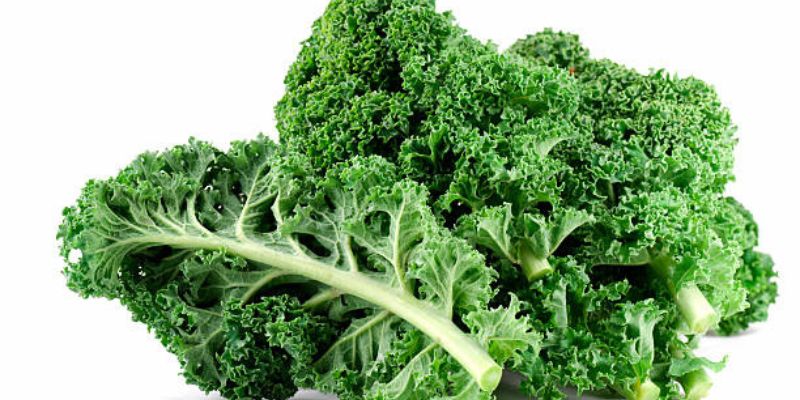
Kale is a leafy green vegetable that grows above ground. It is highly nutritious and famous for its health benefits and cooking versatility. Kale belongs to the Brassica family. This family includes broccoli, cauliflower, and Brussels sprouts.
Kale is known for its hardy nature. It is a staple in many diets and is celebrated in health-conscious culinary circles.
Characteristics
- Varieties: Several varieties of kale exist. These include curly kale, lacinato or dinosaur kale, and Red Russian kale. Each variety has its texture and flavor.
- Flavor and Texture: Kale’s flavor is slightly bitter and earthy. You can soften this flavor by cooking or massaging the leaves. Curly kale is more robust, while Lacinato kale has a softer texture.
- Appearance: The kale leaves can range from deep green to purplish, with flat or curly edges, depending on the variety.
Nutritional Value
- Rich in Vitamins: Kale contains vitamins A, C, and K. It contains reasonable amounts of calcium, iron, and manganese.
- Antioxidants: Kale is rich in antioxidants, such as quercetin and kaempferol. These antioxidants are linked to health benefits.
- Fibre Content: Kale is rich in dietary fiber. This fiber helps with digestion.
Growing Conditions
- Climate: Kale, a cool-weather crop, grows well in various temperatures, showing its versatility.
- Soil: Kale prefers well-drained, fertile soil rich in organic matter.
- Watering: Requires consistent moisture for optimal growth.
Cultivation Methods
- Planting: Kale can be grown from seeds or transplants and is often planted in early spring or late summer for a fall harvest.
- Spacing: Plants should be about 12 to 18 inches apart for proper growth.
- Pest Management: Kale attracts pests such as aphids and cabbage loopers, requiring careful monitoring and prevention.
Uses In Cuisine
- Cooking Methods: Can be eaten raw in salads (especially when the leaves are massaged), steamed, boiled, sautéed, or added to smoothies.
- Dishes: Popular in dishes like kale chips, soups, stews, and as a side dish when sautéed with garlic and oil.
- Nutrient Retention: Steaming kale helps retain nutrients and soften tough fibers.
Kale’s rich nutrient profile, particularly its high vitamin content, makes it a favorite among health enthusiasts. Its adaptability in the kitchen, from raw preparations to cooked dishes, adds to its appeal. Easy to grow and resilient, kale is a common feature in both home gardens and commercial agriculture.
Spinach
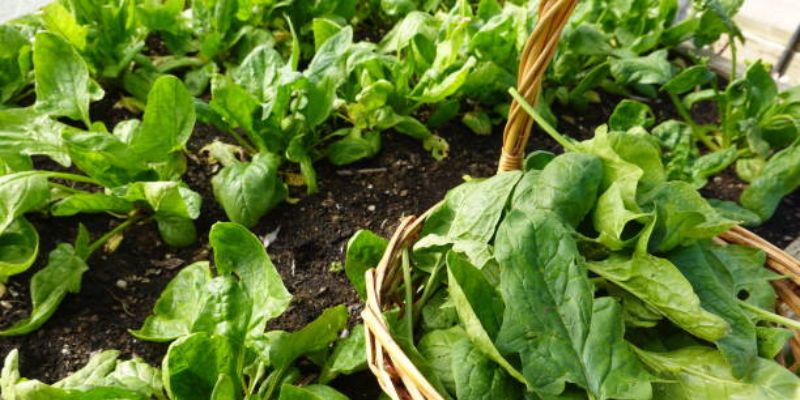
Spinach is a highly nutritious and versatile leafy green vegetable that grows above ground. Known for its tender leaves and mild flavor, spinach is a staple in many cuisines worldwide. Spinach belongs to the Amaranthaceae family and is celebrated for its quick growth and rich nutritional profile.
Characteristics
- Varieties: There are several spinach varieties, including smooth-leaf, savoy (crinkly leaf), and semi-savoy. Each type has a slightly different texture but similar flavor profiles.
- Flavor and Texture: Young spinach has a delicate, slightly sweet taste but becomes more earthy and robust as it matures.
- Appearance: Spinach leaves with a vibrant green color can be flat or slightly wrinkled.
Nutritional Value
- Rich in Vitamins and Minerals: Spinach is an excellent source of vitamins A, C, and K, iron, folate, and magnesium.
- Low Calories: It’s low in calories, making it an excellent choice for weight-conscious diets.
- Antioxidants: Spinach contains high levels of antioxidants, including lutein and zeaxanthin, which are beneficial for eye health.
Growing Conditions
- Climate: Being a cool-weather crop, spinach can tolerate frost but tends to bolt in hot weather.
- Soil: Spinach prefers well-drained, fertile soil with a neutral to slightly alkaline pH.
- Watering: Consistent watering is essential to moisten the soil, especially in dry conditions.
Cultivation Methods
- Planting: Spinach can be grown from seeds and is often planted in early spring or late summer/early fall.
- Spacing: Plants should be spaced about 4-6 inches apart to allow for leaf expansion.
- Succession Planting: Planting in intervals can ensure a continuous harvest.
Uses In Cuisine
- Versatile Ingredient: Spinach can be eaten raw in salads, sandwiches, and smoothies or cooked in soups, stews, sautés, and omelets.
- Pairing: Spinach’s mild flavor pairs well with garlic, lemon, dairy (especially cheese), and nuts.
- Nutrient Retention: Spinach retains its nutritional value best when cooked lightly, such as steaming or quick sautéing.
Spinach is a popular choice in kitchens due to its versatility and nutritional benefits, particularly its high vitamin and mineral content.
Gardeners favor spinach for its rapid growth and ease of cultivation, making it a rewarding crop for both novices and experts.
Brussels Sprouts
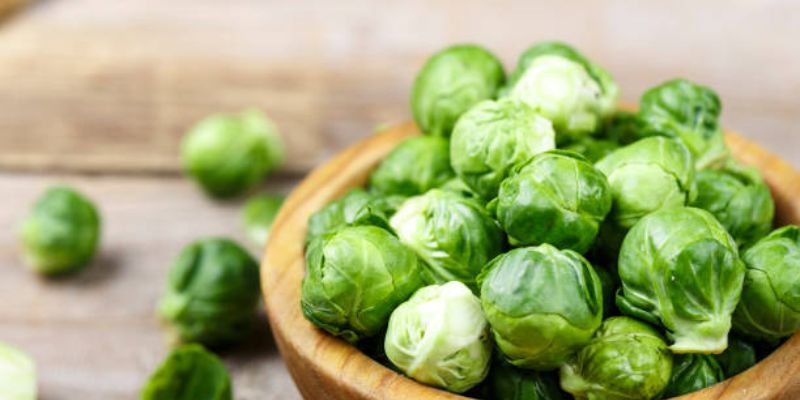
Brussels sprouts, a distinctive vegetable, grow above ground. They are small, round, and look like miniature cabbages. Brussels sprouts and broccoli, kale, and cauliflower are part of the Brassica family.
People celebrate Brussels sprouts for their unique taste and nutritional benefits. They have become more prevalent in many cuisines.
Characteristics
- Growth Habit: Brussels sprouts mature from the bottom up on their stalks.
- Appearance: They are typically about 1-1.5 inches in diameter, with compact, green heads. Some varieties may have a purplish hue.
- Flavor: Their flavor is slightly bitter and nutty but becomes sweeter with frost or proper cooking.
Nutritional Value
- Rich in Nutrients: Brussels sprouts are high in fiber, vitamins C and K, and contain reasonable amounts of folate, manganese, and vitamin B6.
- Antioxidants: They are rich in antioxidants and compounds that might prevent cancer.
- Low Calories: Despite their dense nutrient content, they are low in calories.
Growing Conditions
- Climate: They thrive in cooler temperatures and tolerate frost, which enhances their flavor.
- Soil: They grow best in well-drained, fertile soil rich in organic matter.
- Watering: Require consistent moisture for optimal growth.
Cultivation Methods Planting
Brussels sprouts are typically grown from transplants rather than being direct-seeded.
- Spacing: Plants should be spaced about 18-24 inches apart.
- Harvesting: Sprouts are harvested when firm and green, typically starting from the lower stalk.
Uses In Cuisine Cooking Methods
Brussels sprouts can be roasted, steamed, boiled, or sautéed; roasting especially brings out their natural sweetness.
- Pairing: Pairs well with flavors like garlic, bacon, balsamic vinegar, and mustard.
- Preparation: Removing the outer leaves and cutting a small cross in the base of Brussels sprouts can help them cook more evenly.
Brussels sprouts have become a favorite in modern cooking for their complex flavor and health benefits. Their high nutrient content, particularly in vitamins C and K, makes them valuable to a healthy diet.
Brussels sprouts can be challenging to grow because of their long growing season and space requirements; however, their unique taste and nutritional benefits make them a rewarding crop for diligent cultivators.
Cabbage

Cabbage, a plant with leafy green, red, or pale green heads, grows biennially but is farmed annually. The Brassica family includes cabbage, broccoli, cauliflower, and Brussels sprouts. Many people eat cabbage worldwide because it’s versatile in cooking and nutritious.
Characteristics
- Varieties: Cabbage comes in various types like green, red, Savoy, and Napa, each unique in characteristics.
- Flavor and Texture: Green cabbage tastes slightly peppery, and red cabbage has a robust, earthy flavor. Savoy cabbage is milder and more tender, and Napa cabbage, often used in Asian cuisine, is sweet and crunchy.
- Appearance: Cabbage heads can be round to elongated and vary in size. The leaves can be smooth or crinkled, depending on the type.
Nutritional Value
- Rich in Vitamins and Minerals: Cabbage is rich in vitamins C and K. It also has a lot of folate, manganese, and vitamin B6.
- Antioxidants: The red variety is rich in antioxidants like anthocyanins.
- Dietary Fiber: A good source of dietary fiber, beneficial for digestive health.
Growing Conditions
- Climate: Cabbage grows well in cool weather and can survive frost, so it is ideal for planting in spring and fall.
- Soil: Prefers well-drained, fertile soil rich in organic matter.
- Watering: Requires consistent moisture for optimal head development.
Cultivation Methods
- Planting: Gardeners typically grow plants from transplants started indoors or purchased from nurseries.
- Spacing: Plants should be about 12-24 inches apart, depending on the variety.
- Pest Management: Since cabbage attracts various pests, gardeners may need to take preventive and control measures.
Uses In Cuisine
- Versatility: Cabbage can be eaten raw in salads and coleslaws, or it can be cooked in dishes like stews, soups, stir-fries, or fermented to make sauerkraut or kimchi.
- Pairing: Cabbage complements flavors from garlic, onions, apples, and spices, such as caraway.
- Nutrient Retention: Cabbage is best cooked lightly to retain its nutritional value and texture.
Cabbage is famous in gardens and kitchens for its health benefits and culinary flexibility. Its high vitamin content, particularly in vitamins C and K, and its fiber and antioxidant levels make it a nutritious choice for various diets.
Cabbage’s adaptability in recipes, from raw applications to cooked dishes and fermentations, adds to its global appeal.
These revisions aim to clarify the subject and action in each sentence, reducing ambiguity and making the text more accessible to both human readers and NLU models.
Celery
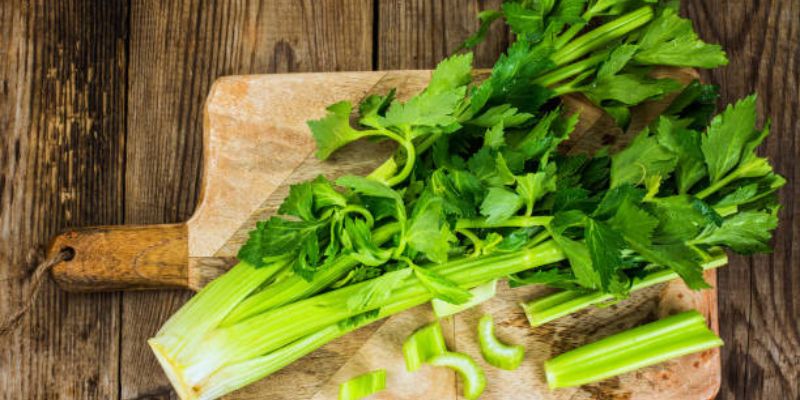
Celery, a plant found in marshlands and part of the Apiaceae family, has been grown as a vegetable since ancient times. This vegetable is known for its long, fibrous stalks that people eat raw or cooked. People appreciate celery for its unique flavor, use as a low-calorie snack, and role in many dishes.
Characteristics
- Appearance: Celery has long, straight, and fibrous stalks topped with leafy greens. It’s usually green, but there are also varieties with golden or white stalks.
- Flavor and Texture: The celery taste is earthy and slightly peppery, with a crisp and crunchy texture.
- Varieties: The main types are common celery, known for its stalks; celeriac, grown for its root; and leaf celery, valued for its aromatic leaves.
Nutritional Value
- Low in Calories: Its low-calorie count makes celery a favorite for weight-loss diets and healthy snacks.
- Vitamins and Minerals: Celery contains reasonable amounts of vitamins K and C, potassium, and folate.
- High Water Content: Celery is known for its high water content, contributing to hydration.
Growing Conditions
- Climate: Celery grows best in cool, moist climates and struggles in high heat.
- Soil: Prefers a rich, well-drained soil with plenty of organic matter.
- Watering: To get crisp, juicy stalks, water the plants consistently.
Cultivation Methods
- Planting: Gardeners typically start celery from seeds indoors and then transplant it into the garden. Compared to many vegetables, celery requires a longer growing season.
- Spacing: Space the plants about 6-8 inches apart.
- Harvesting: Harvest the stalks by cutting them at the soil line when they reach the desired size.
Uses In Cuisine
- Raw Consumption: Commonly eaten raw as a snack, in salads, or as a vehicle for dips.
- Cooking: Celery is a flavor base in soups, stews, and stocks, being part of the ‘mirepoix’ or ‘holy trinity.’
- Juicing and Smoothies: Often included in health-focused juices and smoothies.
Celery’s distinctive flavor and crunchy texture make it a favorite in various dishes. At the same time, its low-calorie content and nutritional benefits, especially in terms of vitamins K and C, make it popular in health-conscious diets.
Celery requires some care, especially with watering, but rewards gardeners with its kitchen versatility.
Squash

Squash is a versatile and nutritious vegetable from the gourd family that grows above ground. Squash is classified into two broad categories: summer and winter squash. Squash varieties come in various shapes, sizes, and colors and are a staple in many cuisines worldwide.
Characteristics Varieties
Popular summer squash includes yellow squash and pattypan squash. Winter squash varieties include butternut, acorn, spaghetti, and kabocha squash.
- Flavor and Texture: Summer squash has a tender texture and mild flavor, while winter squash is denser and typically sweeter.
- Appearance: Farmers harvest summer squash while it’s still young and tender. In contrast, they wait for winter squash to mature, resulting in hard skins and a longer shelf life.
Nutritional Value Vitamins And Minerals
Squash provides vitamins A and C, potassium, and fiber, with winter varieties especially rich in vitamin A.
- Low in Calories: Most squash types are low in calories, so they’re suitable for any diet.
- Antioxidants: Winter squash has many antioxidants, like beta-carotene.
Growing Conditions Climate
Squash prefers warm weather and plenty of sun.
- Soil: Squash thrives in well-drained, fertile soil rich in organic matter.
- Watering: Requires consistent moisture, especially during the flowering and fruiting stages.
Cultivation Methods Planting
Squash is typically grown from seeds and can be directly sown into the garden once the danger of frost has passed.
- Spacing: Squash requires ample space because its vines, especially the winter varieties, can spread widely.
- Pest Control: Squash can be susceptible to pests, such as squash bugs and vine borers, and thus requires preventive measures.
Uses In Cuisine Summer Squash
Summer squash can be eaten raw, grilled, sautéed, or in baking. Zucchini is famous for dishes like zucchini bread and cakes.
- Winter Squash: Winter squash is often roasted, baked, or pureed for soups and pies. Spaghetti squash is used as a low-carb pasta alternative.
- Seeds: The seeds of certain squashes, including pumpkin, can be roasted for a nutritious snack.
Squash is a popular choice in gardens due to its diverse varieties and the wide range of culinary uses. Its nutritional profile, particularly the high content of vitamins A and C in winter squash, makes it a valuable addition to a healthy diet.
The versatility of squash, from summer varieties perfect for light dishes to winter varieties ideal for hearty meals, contributes to its widespread culinary appeal.
Swiss Chard
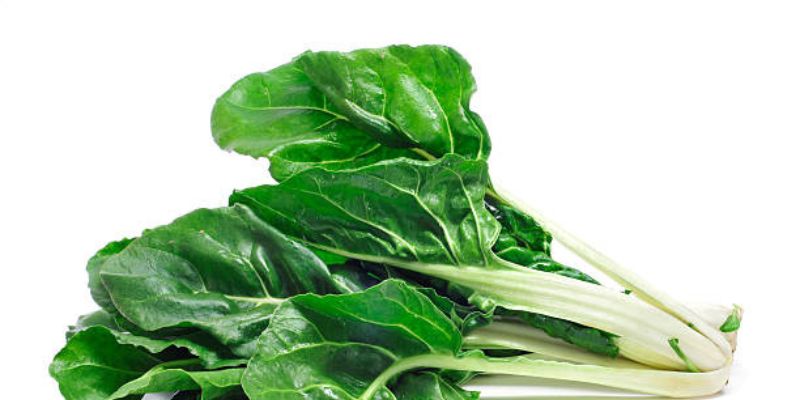
Swiss chard, also known simply as chard, is a leafy green vegetable often grown for its flavorful leaves and crunchy stalks.
Swiss chard is a member of the beet family, grown for its leaves instead of roots. It is known for its nutritional value and is a versatile ingredient in various cuisines.
Characteristics
- Varieties: Swiss chard comes in various colors, including white, yellow, red, and rainbow stalks.
- Flavor and Texture: The leaves taste slightly bitter, like spinach, but become milder upon cooking. The stalks are crunchy and slightly sweet.
- Appearance: Swiss chards have large, dark green leaves and thick, colorful stalks.
Nutritional Value
- Rich in Vitamins and Minerals: It is an excellent source of vitamins A, C, and K and minerals like magnesium, iron, and potassium.
- Antioxidants: They contain antioxidants such as beta-carotene and flavonoids, which are beneficial for health.
- Low in Calories: High fiber and water content while low in calories.
Growing Conditions
- Climate: Swiss chard, a cool-season crop, tolerates warmer temperatures better than most greens.
- Soil: It prefers well-drained, fertile soil rich in organic matter.
- Watering: Requires consistent moisture for optimal growth.
Cultivation Methods
- Planting: You can grow Swiss chard from seeds by direct seeding in the garden or start it indoors and transplant it.
- Spacing: Plants should be spaced about 12 inches apart.
- Harvesting: Harvest the leaves when they are young and tender, or let them grow larger. Remove leaves from the outside to encourage the plant to keep increasing.
Uses In Cuisine
- Versatility: Swiss chard can be eaten raw in salads, sautéed, steamed, or added to soups and stews.
- Flavor Pairings: Swiss chard pairs well with garlic, onions, lemon, and rich ingredients such as cream and cheese.
- Nutrient Retention: Light cooking methods help retain nutrients and vibrant color.
Swiss chard is valued in kitchens for its nutritional benefits and colorful appearance. It’s particularly praised for its high vitamin content and versatility in cooking, from fresh salads to hearty cooked dishes. Easy to grow and resilient, Swiss chards are standard for novice and experienced gardeners.
Arugula
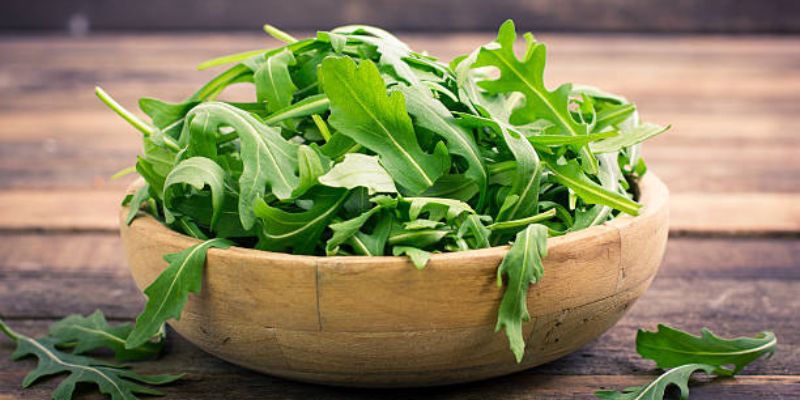
Arugula, or rocket or roquette, is a leafy green vegetable with a distinctive, peppery flavor. Arugula, broccoli, cabbage, and kale belong to the Brassicaceae family. Arugula is popular in salads and as a garnish. It is prized for its unique taste and nutritional benefits.
Characteristics
- Flavor: Arugula has a bold, peppery taste that adds a distinct flavor to dishes. Young leaves are milder, while mature leaves have a more intense flavor.
- Texture: The leaves are tender and slightly chewy.
- Appearance: Arugula leaves are small, lobed, and usually deep green.
Nutritional Value
- Rich In Vitamins And Minerals: Arugula is a good source of vitamins A, C, and K, calcium, potassium, and folate.
- Low in Calories: Arugula is low in calories, making it an excellent choice for weight management diets.
- Antioxidants: Arugula contains phytochemicals like glucosinolates and antioxidants, which are beneficial for health.
Growing Conditions Climate
Arugula grows best in cool weather but can adapt to many climates. In hot weather, it tends to bolt (flower and go to seed).
- Soil: Thrives in well-drained soil rich in organic matter.
- Watering: Requires regular watering to keep the soil consistently moist.
Cultivation Methods Planting
You can sow arugula directly in the garden, which also works well in containers. It germinates quickly and can be harvested a few weeks after planting.
- Spacing: Seeds can be sown closely and thinned out as needed.
- Succession Planting: Planting seeds at different times ensures you always have arugula ready to harvest.
Uses In Cuisine Salads
Arugula is popular in salads, whether alone or mixed with other greens.
- Cooking: You can lightly cook arugula and add it to pasta, pizzas, and sandwiches for a peppery flavor.
- Garnishing: Chefs often use arugula as a flavorful garnish on many dishes.
Arugula’s peppery flavor makes it a favorite in salads and as an accent in various dishes. Its high vitamin content, particularly vitamins A, C, and K, and its low-calorie count contribute to its popularity in health-conscious diets. Easy to grow and quick to harvest, arugula is a common choice for gardeners, especially those with limited space.
Radishes

Each radish is a root vegetable known for its crisp texture and spicy flavor. Radishes belong to the Brassicaceae family, which includes mustard, cabbage, and kale.
Radishes mature quickly and vary in shape, size, and color. This variety makes them popular among gardeners and adds vibrancy to culinary dishes.
Characteristics
- Varieties: Many radish varieties exist, from common small, round red ones to more significant daikon types.
- Flavor and Texture: Radishes usually are crisp and crunchy with a peppery taste, but some can be milder or sweet.
- Appearance: They usually have a round or elongated shape with smooth skin.
Nutritional Value
- Low in Calories: Each radish is low in calories but provides a satisfying crunch.
- Vitamins and Minerals: Radishes provide vitamin C, potassium, folate, and other nutrients.
- Dietary Fiber: Containing dietary fiber, radishes support digestive health.
Growing Conditions
- Climate: Radishes are cool-season crops that grow best in spring and fall. They mature quickly, often in as little as three to four weeks.
- Soil: Prefer well-drained soil rich in organic matter.
- Watering: Radishes require consistent moisture to grow evenly and to prevent them from becoming woody or overly spicy.
Cultivation Methods
- Planting: You can direct-seed radishes in the garden; they are ideal for succession planting because of their quick maturation.
- Spacing: Sow the seeds thinly and then thin them out to give radishes enough space to develop.
- Harvesting: Radishes are best harvested when young and tender, as leaving them in the ground for too long can make them tough and pithy.
Uses In Cuisine
- Raw Consumption: Often eaten raw in salads, as garnishes, or as a crunchy snack.
- Cooking: Can be roasted, pickled, or added to soups and stews for flavor.
- Leaves: Radish greens are edible and can be cooked like other leafy greens.
Radishes are appreciated for their ease of cultivation and quick harvest time, making them a favorite among beginner gardeners and those looking for rapid results.
Their spicy flavor and crisp texture add a unique element to various dishes, and their nutritional benefits, especially their vitamin C content, make them a healthful addition to any diet.
Green Onions
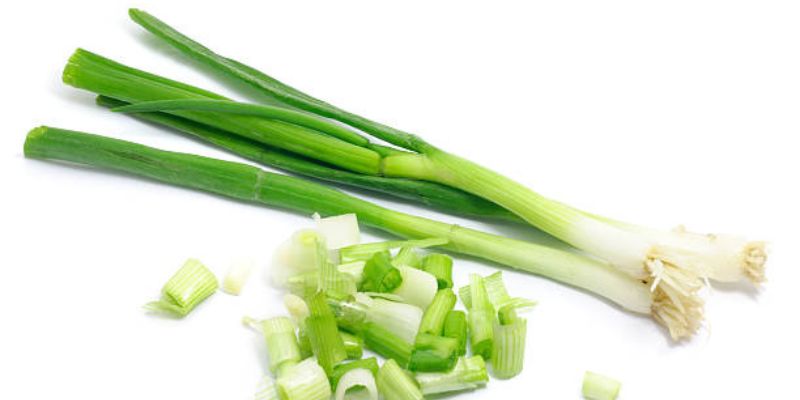
Green onions are a species in the genus Allium. This group also includes garlic, leeks, and chives. People also call them scallions or spring onions.
They are appreciated for their mild flavor and versatility in culinary applications. Green onions are harvested earlier than mature onions. This early harvest gives them a slender shape and a milder taste.
Characteristics
- Flavor and Texture: Green onions are crisp and tender. Their flavor is milder and less sharp than that of regular onions.
- Appearance: They feature long, thin green stalks leading to a white base. This base is usually less bulbous than that of regular onions.
- Varieties: Some varieties are grown specifically to be harvested as green onions. These are essentially young onions but milder in flavor.
Nutritional Value
- Vitamins and Minerals: Green onions are a good source of vitamin K and contain vitamin C, A, and some B vitamins.
- Low in Calories: They are low in calories, making them a healthy addition to many dishes.
- Antioxidants: Green onions contain antioxidants and compounds linked to health benefits.
Growing Conditions
- Climate: Green onions can be grown in various climates and are pretty hardy, often being one of the first crops planted in the spring.
- Soil: Green onions prefer well-drained, fertile soil.
- Watering: They require regular watering to maintain consistent soil moisture for the best growth.
Cultivation Methods
- Planting: Green onions can be grown from seeds or sets with a short growing season and can be harvested just a few weeks after planting.
- Spacing: Green onions can be planted closely together and thinned as needed.
- Regrowth: You can replant the white base with roots or place it in water to regrow the green tops.
Uses In Cuisine
- Versatility: People use green onions as a vegetable and a herb, adding them to salads, soups, stir-fries, and garnishes on various dishes.
- Cooking: Green onions can be cooked or used raw. Their white parts, having a more intense flavor, are often cooked, whereas the milder green parts are commonly used as a fresh topping.
- Pairings complement various flavors and ingredients, from eggs and potatoes to meats and seafood.
Green onions are a popular choice for both gardeners and chefs due to their ease of growth and versatility in the kitchen.
Their mild flavor and nutritional benefits, particularly their vitamin K content, make them a healthful addition to various dishes, from traditional to contemporary cuisines.
Conclusion
The world of vegetables that grow above ground is rich and diverse, offering various flavors, textures, and nutritional benefits.
Cucumbers and radishes offer a crisp, refreshing bite, while squash and broccoli bring a hearty, comforting texture. All these vegetables are essential to many diets and cuisines.
Many vegetables are easy to grow, making them accessible for home gardeners and commercial farmers.
Moreover, they offer significant health benefits with high levels of vitamins, minerals, and fiber, essential for a balanced diet.
Whether raw, roasted, sautéed, or steamed, each vegetable uniquely enhances meals and health.
